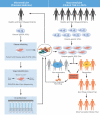Translation of Human-Induced Pluripotent Stem Cells: From Clinical Trial in a Dish to Precision Medicine
- PMID: 27151349
- PMCID: PMC5086255
- DOI: 10.1016/j.jacc.2016.01.083
Translation of Human-Induced Pluripotent Stem Cells: From Clinical Trial in a Dish to Precision Medicine
Abstract
The prospect of changing the plasticity of terminally differentiated cells toward pluripotency has completely altered the outlook for biomedical research. Human-induced pluripotent stem cells (iPSCs) provide a new source of therapeutic cells free from the ethical issues or immune barriers of human embryonic stem cells. iPSCs also confer considerable advantages over conventional methods of studying human diseases. Since its advent, iPSC technology has expanded with 3 major applications: disease modeling, regenerative therapy, and drug discovery. Here we discuss, in a comprehensive manner, the recent advances in iPSC technology in relation to basic, clinical, and population health.
Keywords: drug discovery; human-induced pluripotent stem cells; macromedicine; micromedicine; personalized medicine.
Copyright © 2016 American College of Cardiology Foundation. Published by Elsevier Inc. All rights reserved.
Figures



References
-
- Till JE, McCulloch EA. A direct measurement of the radiation sensitivity of normal mouse bone marrow cells. Radiat Res. 1961;14:213–22. - PubMed
-
- Gurdon JB. The developmental capacity of nuclei taken from intestinal epithelium cells of feeding tadpoles. J Embryol Exp Morphol. 1962;10:622–40. - PubMed
-
- Wilmut I, Schnieke AE, McWhir J, et al. Viable offspring derived from fetal and adult mammalian cells. Nature. 1997;385:810–3. - PubMed
-
- Evans MJ, Kaufman MH. Establishment in culture of pluripotential cells from mouse embryos. Nature. 1981;292:154–6. - PubMed
-
- Thomson JA, Itskovitz-Eldor J, Shapiro SS, et al. Embryonic stem cell lines derived from human blastocysts. Science. 1998;282:1145–7. - PubMed
Publication types
MeSH terms
Grants and funding
LinkOut - more resources
Full Text Sources
Other Literature Sources

